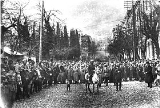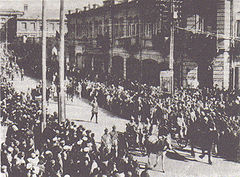
11th Soviet Red Army
Encyclopedia

Red Army
The Workers' and Peasants' Red Army started out as the Soviet Union's revolutionary communist combat groups during the Russian Civil War of 1918-1922. It grew into the national army of the Soviet Union. By the 1930s the Red Army was among the largest armies in history.The "Red Army" name refers to...
was a unit of the then newly created Soviet
Soviet Union
The Soviet Union , officially the Union of Soviet Socialist Republics , was a constitutionally socialist state that existed in Eurasia between 1922 and 1991....
armed forces
Armed forces
The armed forces of a country are its government-sponsored defense, fighting forces, and organizations. They exist to further the foreign and domestic policies of their governing body, and to defend that body and the nation it represents from external aggressors. In some countries paramilitary...
. It was formed by the Bolsheviks on October 3, 1918 from the Red Northern Caucasus Army. In February 1919 it was dissolved and was again deployed in March 1919 as a subdivision of the Caspian-Caucasian Front. It took a prominent part in the sovietization of the three republics of the southern Caucasus in 1920-21, when Azerbaijan
Azerbaijan
Azerbaijan , officially the Republic of Azerbaijan is the largest country in the Caucasus region of Eurasia. Located at the crossroads of Western Asia and Eastern Europe, it is bounded by the Caspian Sea to the east, Russia to the north, Georgia to the northwest, Armenia to the west, and Iran to...
, Armenia
Armenia
Armenia , officially the Republic of Armenia , is a landlocked mountainous country in the Caucasus region of Eurasia...
, and Georgia
Red Army invasion of Georgia
The Red Army invasion of Georgia also known as the Soviet–Georgian War or the Soviet invasion of Georgia was a military campaign by the Soviet Russian Red Army against the Democratic Republic of Georgia aimed at overthrowing the Social-Democratic government and installing the Bolshevik regime...
were brought within the orbit of Soviet Russia. In 1939 the 11th Army (2nd formation) was formed in the Belarussian Special Military District (BSMD) from the former Minsk Army Group.
Russian Civil War
Since the Russian Empire's Caucasus Front (Russian Empire) dissolved, it did not have a true successor organization. The Army of the North Caucasus, which was renamed 11th Army on October 3, 1918, constituted the main army of the Russian RepublicRussian Soviet Federative Socialist Republic
The Russian Soviet Federative Socialist Republic , commonly referred to as Soviet Russia, Bolshevik Russia, or simply Russia, was the largest, most populous and economically developed republic in the former Soviet Union....
in the area during the Russian Civil War
Russian Civil War
The Russian Civil War was a multi-party war that occurred within the former Russian Empire after the Russian provisional government collapsed to the Soviets, under the domination of the Bolshevik party. Soviet forces first assumed power in Petrograd The Russian Civil War (1917–1923) was a...
. During the Russian Civil War
Russian Civil War
The Russian Civil War was a multi-party war that occurred within the former Russian Empire after the Russian provisional government collapsed to the Soviets, under the domination of the Bolshevik party. Soviet forces first assumed power in Petrograd The Russian Civil War (1917–1923) was a...
the 11th Army fought against the White
White movement
The White movement and its military arm the White Army - known as the White Guard or the Whites - was a loose confederation of Anti-Communist forces.The movement comprised one of the politico-military Russian forces who fought...
troops of General Anton Denikin's Volunteer Army
Volunteer Army
The Volunteer Army was an anti-Bolshevik army in South Russia during the Russian Civil War of 1918-1920....
in the western part of the North Caucasus
North Caucasus
The North Caucasus is the northern part of the Caucasus region between the Black and Caspian Seas and within European Russia. The term is also used as a synonym for the North Caucasus economic region of Russia....
. It was the main strength of the Caspian-Caucasian Army Group. In January 1919, the front of 200 miles held by the Red troops along the Caucasus foothills and South Russian steppes was cut into two by the White forces, which resulted in the panic flight of the 11th Red Army.
By 1921, the 11th Red Army is characterized by the modern French historian Marie Broxup as "a purely Russian army led by Russian commanders and Russian political cadres." In May 1921 the army lost its name and was integrated into the Caucasian Front, later part of the North Caucasus Military District
North Caucasus Military District
The North Caucasus Military District was a military district of the Russian Ground Forces, which became in 2010 the Southern Military District and lately also includes the Black Sea Fleet and Caspian Flotilla....
.
The first country to fall in the South Caucasus was the Democratic Republic of Azerbaijan, which was made a Soviet republic in May 1920. Taking advantage of its quarrels with neighboring Armenia, the 11th Army had little difficulty in initially sovietizing Azerbaijan. Although it soon was embroiled in a fierce anti-Soviet insurgency, the army remained poised to advance into the two remaining republics, Armenian and Georgia.
For the time being, however, the authorities in Moscow ordered the army to stand down while negotiations between Russia and Armenia were being carried out. In that brief span the Red Army did aid Armenian communists fighting against the Armenian government in the Ijevan
Ijevan
Ijevan now is a city in Armenia and the capital of Tavush region. It is located in the northern part of the region, on the foot of Ijevan ridge and Nal'teket ridge on both banks of Aghstev River. The city's current name, Ijevan, and its former name Karavansara both mean "inn" , in Armenian and...
region of Armenia.
The head of the 11th Army's Revolutionary Military Council was Sergo Ordzhonikidze
Grigoriy Ordzhonikidze
Grigol Ordzhonikidze ორჯონიკიძე - Grigol Orjonikidze, , generally known as Sergo Ordzhonikidze ; – February 18, 1937) was a Georgian Bolshevik, later member of the CPSU Politburo and close friend to Joseph Stalin...
. The military leaders of the 11th Army were in 1921: V.P. Raspopov, J.P. Butyagin, M.I. Vasilenko, M.K. Levandovski and Anatoli Gekker
Anatoli Gekker
Anatoli Ilyich Gekker was a Soviet military commander involved in the Russian Civil War.Gekker was born into a family of a military doctor in Tiflis , Georgia, then part of Imperial Russia. Having graduated from Vladimir Military School in St Petersburg , he briefly attended the General Staff...
. Military decisions were supervised by the Army's Council of War. Its members were in 1921: Sergey Kirov
Sergey Kirov
Sergei Mironovich Kirov , born Sergei Mironovich Kostrikov, was a prominent early Bolshevik leader in the Soviet Union. Kirov rose through the Communist Party ranks to become head of the Party organization in Leningrad...
, Valerian Kuybyshev, J.P. Butyagin, K.A. Mekhonoshin, Sokolov, J.I. Vesnik, Lukin, B.D. Mikhailov, Kvirkeliya, S.S. Eliava, J.I. Vesnik and P.I. Kushner.
Great Patriotic War
In 1939 the 11th Army (2nd formation) was formed in the Belarussian Special Military District (BSMD) from the former Minsk Army Group. It took part in the Soviet invasion of Poland (1939)Soviet invasion of Poland (1939)
The 1939 Soviet invasion of Poland was a Soviet military operation that started without a formal declaration of war on 17 September 1939, during the early stages of World War II. Sixteen days after Nazi Germany invaded Poland from the west, the Soviet Union did so from the east...
. In summer 1940 it became part of the Baltic Military District
Baltic Military District
The Baltic Military District was a military district of the Soviet armed forces, formed briefly before the German invasion, and then reformed after World War II and disbanded after the fall of the Soviet Union in 1991....
(from August, 17th, 1940 the Baltic Special military district).
When the Germans invaded in June 1941 the 11th Army comprised the 16th Rifle Corps(which included the 5th
5th Rifle Division (Soviet Union)
The 5th Rifle Division of the Soviet Red Army was initially formed in September 1918 as the 2nd Penza Infantry Division. It was later renamed as the 5th Rifle Division , Saratov , Vitebsk , and 'in the name of the Czechoslovak Proletariat'...
, 33rd and 188th Rifle Divisions) and 29th Rifle Corps (179th and 184th Rifle Division
184th Rifle Division
The 184th Red Banner Rifle Division was a Soviet Red Army division during World War II . It was with 29th Rifle Corps of Eleventh Army on June 22, 1941, as part of the Baltic Military District. Most of the soldiers rebelled and joined the cause of the Lithuanian Activist Front...
s) and the 3rd Mechanised Corps
3rd Mechanised Corps (Soviet Union)
The 20th Motor Rifle Division is a formation of the Russian Ground Forces, originally formed within the Soviet Red Army as the 3rd Mechanised Corps....
(640 tanks), the 23rd, 126th and 128th Rifle Divisions, the 42nd and 46th Fortified Regions, and other smaller formations and units. It participated in military operations as part of the Soviet Northwestern Front west and south-western of Kaunas
Kaunas
Kaunas is the second-largest city in Lithuania and has historically been a leading centre of Lithuanian economic, academic, and cultural life. Kaunas was the biggest city and the center of a powiat in Trakai Voivodeship of the Grand Duchy of Lithuania since 1413. During Russian Empire occupation...
and Vilnius
Vilnius
Vilnius is the capital of Lithuania, and its largest city, with a population of 560,190 as of 2010. It is the seat of the Vilnius city municipality and of the Vilnius district municipality. It is also the capital of Vilnius County...
.
Since July 9, 1941, it had under its command the 1st Rifle Corps (Soviet Union)|41st22nd Rifle Corps]] and the [[1st Mechanized Corps (Soviet Union), the 4th
4th Rifle Division (Soviet Union)
The 4th Rifle Division was an infantry division of the Soviet Union's Red Army active from 1921 to 1946.The Division was activated 1919 near Petrograd during the Russian Civil War, and fought on the western front of that war and in the Soviet-Polish War. Until 1923 its headquarters was at Minsk...
, 96th, 260th, 273rd and 323rd Rifle Division, the 225th Tank Regiment and other units. From July 30 11th Army joined the Bryansk Front
Bryansk Front
The Bryansk Front was a Front of the Soviet Army during the Second World War.General Andrei Yeremenko was designated commander of the Front when it first formed in mid-late August 1941, comprising, in Erickson's words, 'on paper two armies, 50th and 13th, with eight rifle divisions each, three...
, and fought in the Battle of Kursk
Battle of Kursk
The Battle of Kursk took place when German and Soviet forces confronted each other on the Eastern Front during World War II in the vicinity of the city of Kursk, in the Soviet Union in July and August 1943. It remains both the largest series of armored clashes, including the Battle of Prokhorovka,...
. In December 1943 the 11th Army was dissolved, with the personnel being integrated into other Soviet armies.
The commanders of the 11th Army were:
- 1939 - V. I. Morosov, P. A. Kurtoshkin, A. I. Lopatin and I. I. Fedyuninski.
- Pavel KurochkinPavel Kurochkin-Biography:Pavel Kurochkin was born in the village of Gronevo, Vyazma district, Smolensk Oblast.-Military career:He joined the Red Army in 1918. Kurochkin completed his cavalry courses in Petrograd in 1920...
commanded the 11th Army from November 1942 to March 1943
External links
- Orbat.com/Niehorster, Order of Battle, 22 June 1941 History of the 11th Soviet Red Army

